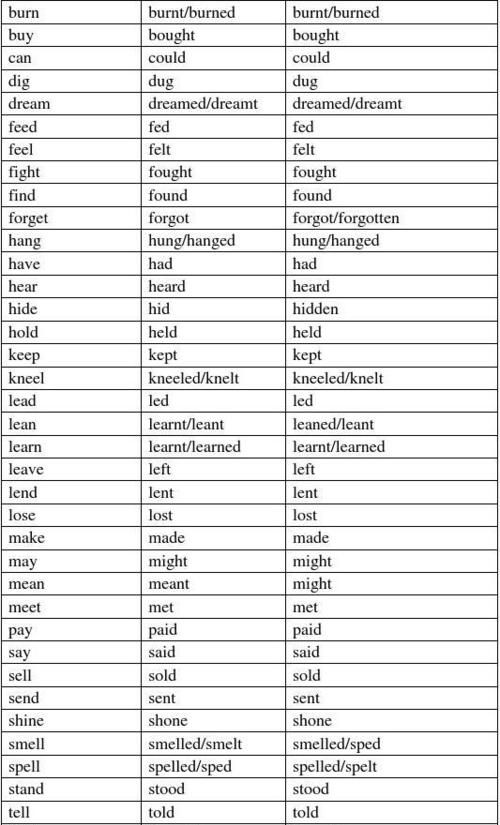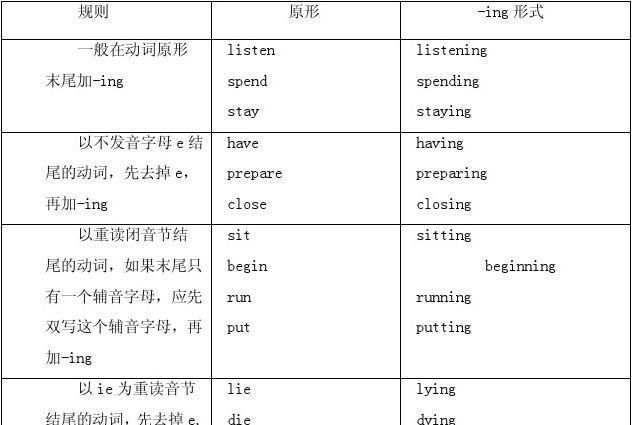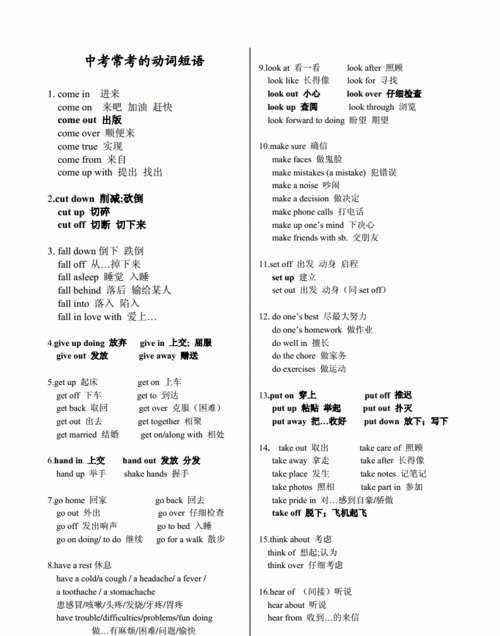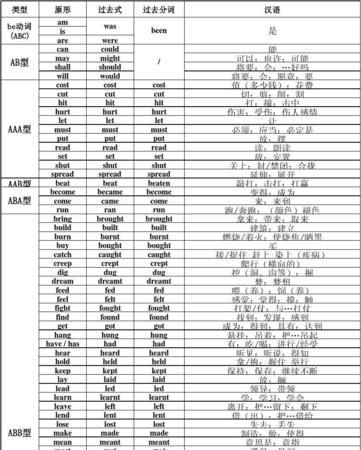本文目录
初一到初三英语动词短语
[短语、词组归纳]
由动词开头构成的短语、词组很多。复习时应分类处理:
一、动词+介词
1.look at…看…, look like … 看上去像……, look after …照料…
2.listen to…听……
3.welcome to…欢迎到……
4.say hello to …向……问好
5.speak to…对……说话
此类短语相当于及物动词,其后必须带宾语,但宾语无论是名词还是代词,都要放在介词之后。
二、动词+副词
“动词+副词”所构成的短语义分为两类:
A.动词(vt.)+副词
1.put on 穿上 2.take off脱下 3.write down记下
此类短语可以带宾语,宾语若是名词,放在副词前后皆可;宾语若是人称代词,只能放在副词的前面。
B.动词(vi)+副词。
1.come on赶快 2.get up起床 3.go home回家
4.come in进来 5.sit down坐下 6.stand up起立
此类短语属于不及物动词,不可以带宾语。
三、其它类动词词组
1.close the door 2.1ook the same 3.go to work/class
4.be ill 5.have a look/seat 6.have supper
7.1ook young 8.go shopping 9.watch TV/games
10. play games
[介词短语聚焦]
“介词+名词/代词”所构成的短语称为介词短语。现将Unitsl-16常用的介词短语按用法进行归类。
1.in+语言/颜色/衣帽等,表示使用某种语言或穿着……。
2.in + Row/ Team/ Class/ Grade等,表示“在……排/队/班级/年级”等。
3.in the morning/ afternoon/ evening/ 表示“在上午/下午/傍晚”等一段时间。
4.in the desk/ pencil-box/bedroom 等表示“在书桌/铅笔盒/卧室里”。
5.in the tree表示“在树上 (非树本身所有)”;on the tree表示“在树上(为树本身所有)”。
6.in the wall表示“在墙上(凹陷进去)”;on the wall表示“在墙上(指墙的表面)”。
7.at work(在工作)/at school(上学)/at home(在家)应注意此类短语中无the。
8.at + 时刻表示钟点。
9.like this/that表示方式,意为“像……这/那样”。
10.of短语表示所属关系。
11.behind/ beside/ near/ under+ 名词等,表示方位、处所。
12.from与to多表示方向,前者意为“从……”,后者意为“到……”。
另外,以下这些短语也必须掌握。如:on duty, after breakfast, at night, at the door, in the middle, in the sky, on one’s bike等。
[重点句型大回放]
1.I think…意为“我认为……”,是对某人或某事的看法或态度的一种句型。其否定式常用I don’t think…,
2.give sth. to sb./ give sb. sth. 意为“把……给……”,动词give之后可接双宾语,可用这两种句型;若指物的宾语是人称代词时,则只能用give it/ them to sb.
3.take sb./ sth. to…意为“把……(送)带到……”,后常接地点,也可接人。
4.One…, the other…/One is…and one is…意为“一个是……;另一个是……”,必须是两者中。
5.Let sb. do sth. 意为“让某人做某事”,人后应用不带to的动词不定式,其否定式为Don’t let sb,do sth.,或Let sb. not do sth. 另外,Let’s 与Let us的含义不完全相同,前者包括听者在内,后者不包括听者在内,
6.help sb. (to) do sth./help sb. with sth.意为“帮助某人做某事”,前者用不定式作宾补,后者用介词短语作宾补,二者可以互换.
7.What about…?/How about…?意为“……怎么样?”是用来询问或征求对方的观点、意见、看法等。about为介词,其后须接名词、代词或V-ing等形式。
8.It’s time to do…/ It’s time for sth. 意为“该做……的时间了”,其中to后须接原形动词,for后可接名词或V-ing形式。
9.like to do sth./like doing sth.意为“喜欢做某事”, 前一种句型侧重具体的一次性的动作;后一种句型侧重习惯性的动作,
10.ask sb.(not) to do sth. 意为“让某人(不要)做某事”,其中ask sb.后应接动词不定式,
11.show sb. sth. / show sth. to do. 意为“把某物给某人看”,该句型的用法同前面第2点。
12.introduce sb. to sb. 意为“把某人介绍给另一人”;introduce to sb.则是“向某人作介绍”。
[重点短语快速复习]
1.kinds of 各种各样的
2. either…or…或者……或者……,不是……就是……
3. neither…nor…既不……也不……
4. Chinese tea without, anything in it 中国清茶
5. take a seat 就坐
6. home cooking 家常做法
7. be famous for 因……而著名
8. on ones way to在……途中
9. be sick/ill in hospital生病住院
10. at the end of在……的尽头,在……的末尾
11. wait for 等待
12. in time 及时
13. make one’s way to…往……(艰难地)走去
14. just then 正在那时
15. first of all 首先,第一
16. go wrong 走错路
17. be/get lost 迷路
18. make a noise 吵闹,喧哗
19. get on 上车
20. get off 下车
21. stand in line 站队
22. waiting room 候诊室,候车室
23. at the head of……在……的前头
24. laugh at 嘲笑
25. throw about 乱丢,抛散
26. in fact 实际上
27. at midnight 在半夜
28. have a good time=enjoy oneself玩得愉快
29. quarrel with sb. 和某人吵架
30. take one’s temperature 给某人体温
31. have/get a pain in…某处疼痛
32. have a headache 头痛
33. as soon as… 一……就……
34. feel like doing sth. 想要干某事
35. stop…from doing sth. 阻止……干某事
36. fall asleep 入睡
37. again and again再三地,反复地
38. wake up 醒来,叫醒
39. instead of 代替
40. look over 检查
41. take exercise运动
42. had better(not) do sth. 最好(不要)干某事
43. at the weekend 在周末
44. on time 按时
45. out of从……向外
46. all by oneself 独立,单独
47. lots of=a lot of 许多
48. no longer/more=not…any longer/more 不再
49. get back 回来,取回
50. sooner or later迟早
51. run away 逃跑
52. eat up 吃光,吃完
53. run after 追赶
54. take sth. with sb. 某人随身带着某物
55. take(good) care of…=look after…(well) (好好)照顾,照料
56. think of 考虑到,想起
57. keep a diary 坚持写日记
58. leave one by oneself 把某人单独留下
59. harder and harder 越来越厉害
60. turn on打开(电灯、收音机、煤气等)
61. turn off 关
很全的哦~~

初中英语所有的to do和doing的词组
一、带动词ing形式
1. keep doing坚持做某事
2. keep sb. doing使某人一直做某事
3. practise doing sth.练习做某事
4. enjoy doing喜欢做某事
5. finish doing完成做某事
6. be afraid of doing 害怕做某事
be busy doing 忙于做某事
7. look forward to doing盼望做某事
8. how about doing、./what about doing做某事怎么样
9. spend some time (in)doing花时间做某事
10. spend some money (in) buying 花钱做某事
11. feel like doing想做某事
12. stop/keep/prevent … from doing阻止某人做某事
13. thank sb for doing感谢某人做某事
14. thanks for doing感谢做某事
15. do some cooking/cleaning/reading/shopping/washing做点饭、打扫一下卫生、读点书、逛逛街、洗洗衣服
16. go swimming/fishing/shopping/skating/boating去游泳、钓鱼、 逛街、 滑冰、 划船
17. mind doing介意做某事
18. can’t help doing情不自禁做某事
19. consider doing考虑做某事
20. have fun doing sth.. 做某事有趣
21. have difficulty doing sth做某事有困难
have trouble doing sth做某事有困难
have problem doing sth 做某事有困难
22. waste time/money doing浪费时间或金钱做某事
23. instead of doing代替做某事
24. miss doing 错过做某事
25. hold on to doing坚持做某事
26. pay attention to doing集中精力做某事
27. suggest doing建议做某事
28. It’s time for doing 到该做某事的时间了
It’s time to do sth. 到该做某事的时间了
29. There is sb doing sth有人正在做某事
30. be used to doing sth 习惯做某事
31. be used for doing sth被用来做某事
32. have a lot of experience具有做某事的丰富经验
33 sb allow doing sth允许做某事
34. put off doing sth推迟做某事
35. succeed in doing sth 成功做某事
36. end up doing以做某事结束
37. give up doing放弃做某事
二.含有不带to的动词不定式句型:
1. had better (not) do sth.最好(不)做某事
2. would you please (not) do sth 你可以做某事吗?
3. why not do sth.为什么不做某事?
why don’t you do sth.为什么你不做某事?
4. Shall we do sth.?我们要做某事吗?
5. let sb do sth.让某人做某事
6. make sb. do sth. have sb do sth使某人做某事
7. feel sb do sth感觉某人做某事
三、含有带to的动词不定式句型
1. It’s time to do sth. 该是做某事的时候了
2. It takes sb. some time to do sth做某事花了某人时间
3. tell/ ask/ want/encourage/invite/ sb. to do sth.告诉、叫、想、鼓励、 邀请某人做某事
4. Would you like to do sth.?你想做某事吗?
5. It’s good/bad to do sth做某事好/不好
6. It’s good/bad for sb.to do sth.对某人来说,做某事好/不好
7. be +adj.+ enough to do sth.足够+形容词做某事
8. sb. is ready to do sth.某人准备好做某事
9. It’s + adj.+ for sb. to do sth. 做某事对某人+形容词(做这件事对你好)
10. It’s + adj.+ of sb. to do sth某人做某事+形容词 (你做这事真好)
11. would like/love /decide/want/wish/to do sth. 想、喜欢、决定、想、希望做某事
12. would like/love sb. to do sth.想让某人做某事
13. prefer to do rather than do sth.宁愿做某事而不愿做某事
例如:I prefer to read rather than write .意思同 I prefer reading to writing. 又如:I prefer to stay at home rather than go out.
再如:prefer=like better ,即:I prefer red.=I like red better.
14. how/ when/where/whether to do sth怎么、什么时候、在哪里、要不要做某事
15. can’t wait to do 迫不及待做某事
16. too … to do … 太怎么样而不能做某事
17. be afraid /ready/able/sure to do害怕、准备、能够、确定做某事
18. It’s time to do sth到该干某事的时候了
19. My job is to do sth我的工作是做某事
20. My dream is to do sth我的梦想是做某事
21. My hobby is to do sth我的业余爱好是做某事
22. refuse to do sth拒绝做某事
23. warn sb to do sth告诫某人做某事
24. pretend to do sth假装做某事
25. teach/learn to do sth 教做某事、/学习做某事
26. need to do sth需要做某事
27. be willing to do sth愿意做某事
28. .try to do sth努力做某事
29. try one’s best to do sth尽某人最大努力做某事
30. agree to do sth同意做某事
31. seem to do sth 好像似乎做某事
32. plan to do sth /make a plan to do sth计划做某事
33. in order to do sth 为了做某事
34. have a chance to do sth有机会做某事
35. find it +adj + for sb to do sth发现做某事是……
36. have sth to do有某事要做
37. There is sth for sb to do对某人来说,有某事要做
38. be anxious to do渴望做某事
39. afford to do sth 支付得起做某事
四、两个动作连用,表目的:
40. used to do sth 过去常常做某事
41. be used to do sth被用来做某事
42. be supposed to do sth理应做某事,应该做某事
43. allow sb to do sth允许某人做某事
44. sb be allowed to do sth某人被允许做某事
45. the best way is to do sth最好的方法是做某事
46. the next step is to do sth 下一步是做某事
47. have nothing to do with 与某事无关
48. the first thing is to do sth第一件事是做某事
49. it’s best to do sth最好做某事
50. it’s a good time to do sth这是做某事的最好时间
it is a good way to do sth 做某事是个好的办法
51. add to do补充做某事
52. urge sb to do 催促某人做某事
53. educate sb to do 教育某人做某事
54. wait for sb to do等待某人做某事
55. order sb to do命令某人做某事
56. happen to do sth碰巧做某事
57. lead sb to do sth领导某人做某事
58. it's a good place to do sth这是做某事的好地方
59. invite sb to do邀请某人做某事
60. get to do sth设计做某事
61. expect to do 期望做某事
62. volunteer to do sth志愿做某事
63. offer to do sth 主动提供做某事
64. have an opportunity to do有机会做某事
65. get sb to do sth使某人做某事
66. it’s one’s duty to do sth做某事是某人的责任
67. use sth to do sth用某物做某事
68. be sure to do sth一定会做某事
69. have to do sth不得不做某事
70. be able / unable to do sth能够 /不能做某事
五、既用带to的动词不定式又用ing形式的句型:
1. stop to do/ doing停下来做另一件事 /停止做某事
2. forget to do/ doing忘记去做某事 /忘记做过某事
3. remember to do/doing记住去做某事/记得做过某事
4. go on to do/doing继续做另一件事 /继续做某事
5. like to do/doing 喜欢做某事(临时 /长期)
6. love to do/doing 喜欢做某事 (临时 /长期)
7. prefer to do/doing 更喜欢做某事 (临时 /长期)
8. hate to do/doing讨厌做某事(临时 /长期)
六、下列结构用带to的动词不定式和ing形式含义相同:
1. begin to do/doing开始做某事
2. start to do/doing开始做某事
3. continue to do/doing继续做某事
4. go on doing 继续做某事
5. take turns to do/doing 轮流做某事
七、既用不带to的动词不定式又用现在分词的句型:用不带to的动词不定式强调动作的完成过程;用现在分词强调动作的进行状态。
hear sb do sth./doing听见某人做某事/ 听见某人正在做某事
listen to sb do sth./doing听某人做某事/听某人正在做某事
look at sb do sth./doing 看某人做某事 /看某人正在做某事
see sb do sth./doing看见某人做某事 /看见某人正在做某事
watch sb do sth./doing观察某人做某事 /观察某人正在做某事
notice sb do sth/doing注意到某人做某事 /注意某人正在做某事

中考英语动词和动词短语

初中英语常见动词过去分词
1. A---A---A型(现在式、过去式和过去分词同形)
动词原形(现在式) 过去式 过去分词
cost cost cost 花费
cut cut cut 割,切
hit hit hit 打
let let let 让
put put put 放下
read read read 读
hurt hurt hurt 伤
2. A---A---B型(现在式和过去式同形)
beat beat beaten 打
3. A---B---A型(现在式和过去分词同形)
come came come 来
become became become 变
run ran run 跑
4. A ---B ---B型
(1)在动词原形后加一个辅音字母d或t构成过去式或过去分词。
burn burnt burnt 燃烧
learn learned/learnt learned/learnt 学习
mean meant meant 意思
hear heard heard 听见
(2)把动词原形的最后一个辅音字母“d”改为“t” 构成过去式或过去分词。
build built built 建筑
lend lent lent 借给
lose lost lost 失去
send sent sent 送
spend spent spent 花费
(3)其他
pay paid paid 付
lay laid laid 下蛋
say said said 说
bring brought brought 带来
buy bought bought 买
think thought thought 想
sleep slept slept 睡
keep kept kept 保持
sweep swept swept 扫
stand stood stood 站
understand understood understood 明白
win won won 得胜
shine shone/shined shone/shined 发光
catch caught caught 抓住
teach taught taught 教
feel felt felt 觉得
fight fought fought 战斗
find found found 发现
get got got 得到
hang hanged/ hung hanged/ hung 绞死,挂
have had had 有
hold held held 盛,握
leave left left 离开
make made made 制造
meet met met 遇见
sell sold sold 卖
shoot shot shot 射击
tell told told 告诉
smell smelt/smelled smelt/smelled 嗅,闻
sit sat sat 坐
dig dug dug 挖
5. A---B---C型(现在式、过去式和过去分词都不相同)
(1)在动词原形后加-n或-en构成过去分词。
eat ate eaten 吃
fall fell fallen 落下
steal stole stolen 偷
give gave given 给
freeze froze frozen 冻结
take took taken 拿
see saw seen 看见
write wrote written 写
ride rode ridden 骑
drive drove driven 驾驶
throw threw thrown 抛,扔
blow blew blown 吹
grow grew grown 生长
know knew known 知道
fly flew flown 飞
draw drew drawn 拉,绘画
show showed shown 展示
(2)过去式加-n或-en构成过去分词。
speak spoke spoken 说话
break broke broken 破碎,折断
wake waked/ woke waked/ waken 醒
choose chose chosen 选择
forget forgot forgotten 忘记
(3)变单词在重读音节中的元音字母“i”分别为“a”(过去式)和“u”(过去分词)。
begin began begun 开始
ring rang rung 按铃
sing sang sung 唱
sink sank sunk 沉
swim swam swum 游泳
drink drank drunk 饮
(4)其他不规则动词的变化。
be(am, is) was/ were been 是
be(are) were been 是
do did done 做
go went gone 去
lie lay lain 躺
wear wore worn 穿

以上就是关于中考动词常考 ,初一到初三英语动词短语的全部内容,以及中考动词常考 的相关内容,希望能够帮到您。

